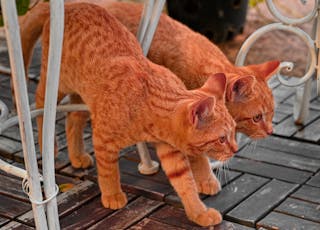
Petting aggression in cats can be an extremely disconcerting and potentially dangerous issue. While some cats enjoy being handled, others may become aggressive or fearful when petting is continued for too long or in an incorrect manner. As an owner, it's important to understand the causes of this type of aggression and learn to prevent or stop it from happening.
First off, it’s important for owners to identify which type of aggression their cat is displaying. If a cat growls, hisses, swat at you with its paws, or even bites during petting then it’s likely petting aggression. Cats display different body language when they are uncomfortable with being touched such as staying alert with ears back and dilated pupils. If your cat displays any of these signs while being petted then chances are they do not want to be touched anymore.
Once the behaviour has been identified, there are several ways to reduce or stop petting related aggression in your cat. One thing to keep in mind is that all cats are different and patience should be exercised while training them not to display such aggressions anymore. The first step is avoiding over-petting by recognizing the signs that your cat has had enough physical touch. If this doesn’t work then you can try more calming techniques such as providing a distraction like playing a game of chase with a piece of string or dangling toy. You can also slowly introduce new types of touch such as scratching around the chin or behind the ears which cats seem to enjoy much more than belly rubs and long fur strokes. Lastly, associate petting positively by providing treats during periods of calm behaviour after being petted so to create a desired association between petting and good things instead of fear or aggression.
Overall, understanding your cat’s triggers for aggression will help greatly when attempting to reduce or eliminate aggressive behaviour when being handled during petting sessions.. With patience and consistency with training behaviors out of them you should eventually see positive results!
What causes petting aggression in cats?
When it comes to cats, there is nothing more disconcerting than petting aggression. Petting aggression in cats can be caused by a variety of things, including an overstimulated cat, fear of the petting experience, or because the cat is highly territorial and does not want to share its resources.
First and foremost, it’s important to keep in mind that petting any animal has its limits. Overstimulation can cause a cat’s emotions to quickly go from relaxed to anxious. An intense session of petting can lead a cat to suddenly pull away due to feeling overwhelmed. If this warning sign is ignored, then the cat may become more aggressive and could potentially scratch or bite as an instinctive response when faced with too much prolonged contact. It's important for the safety of both humans and cats that you know your cat’s boundaries before trying any type of petting session. Cats typically communicate their needs through body language; watch out for early signs such as flattening ears or licking lips before rubbing its fur the wrong way and leading you into trouble.
Fear can also be a major cause of petting aggression in cats. If the environment has too many unfamiliar equipment such as strange or loud noises, sudden movements from multiple people or other animals running around too rapidly then this can induce fear in cats which again will turn to aggression if not appropriately managed. Just like people, cats need consistency and calm in order for them feel safe allowing trust to build. Properly introducing people and having them interact little by little can provide a safer atmosphere and positive experience for both parties involved; A great way of increasing that bond is through food based rewards!
Finally territoriality also plays an important role in some forms of petting aggression in cats; despite the fact that they are usually solitary animals when unrequested disruptions occur they get put on edge which once again will result in them becoming more aggressive if not taken care off correctly by limiting those negative interactions while promoting positive ones through playtime and socialization activities. Babysitting Isn't just reserved For humans!
In conclusion even though it may seem harmless sometimes directly petting a Cat without knowing what their reaction might be could prove highly detrimental leading up to Increasing levels of agitation which could potentially lead up to more serious consequences; Understanding how each animal reacts certain situations can help diffuse this situation by avoiding unpleasant experiences while reinforcing those positive moments that promote mutual understanding between both species.
What is the best way to manage petting aggression in cats?
When a cat becomes aggressive during petting, it means that the animal is showing signs of stress. Petting aggression in cats ranges from mild indications that disrupted the moment like an abrupt paw strike or a bite, to more serious incidents such as growling and hissing or a jump and run away.
The best way to manage petting aggression in cats is by understanding why they become aggressive in the first place. The most common cause of petting aggression is overstimulation — when cats become overwhelmed with being touched and feel the need to protect themselves. Knowing your cat’s signals of discomfort, such as fur standing on end, flattening ears against their head, intense tail swishing, tense body and hunched posture can help prevent issues with petting aggression.
If your cat does start exhibiting aggressive behavior while being petted, the best course of action is to immediately stop the petting session allowing the cat to gain physical and emotional distance. Once your cat has recovered from feeling overwhelmed or overstimulated it may be necessary to reintroduce gentler petting techniques addressing your cats individual comfort zones and physical tolerances at a slow pace in short intervals. Additionally, providing alternative outlets for exploring such as playtime which stimulates activity levels through interactive toys can help decrease instances of direct petting reinforcement making for a calmer and gentler experience for both owner and kitty — leading to long lasting mutual trust between humans and felines.
How can I tell if my cat is displaying petting aggression?
If you’re a cat owner, you might have noticed your pet becoming increasingly uncomfortable or hostile when petted. This is what is known as petting aggression, and it is important to learn to spot this behavior in your cat so as to avoid causing any distress.
First and foremost, pay attention to your cat’s body language when you are petting them. If they appear tense, twitch their tail or fur, flinch away from you, startle easily and seem agitated they could be displaying signs of petting aggression. They may also try to move away from you or even swat at or bite at you. Because cats generally dislike being touched on certain parts of their bodies such as the abdomen or tail tip, take extra caution approaching these areas.
Another way to determine if your cat is displaying signs of petting aggression is by looking for other cues in their behavior. If your cat leans into your hand or rubs against it seeking more attention, purrs and shows an enjoyable expression on its face its unlikely that they are displaying signs of aggression. Cats also generally enjoy being scratched along the side of the cheeks in an upward motion with your index finger and thumb. When scratched in this area kittens produce a particularly excessive vocalisation known as purr-meows which serves as a hint that they are enjoying the sensation. If your cat exhibits these behaviors then there is unlikely to be any sign of aggression present while petting them.
Understanding when a cat displays petting aggression can help keep interactions between cats and owners positive and informative. It can also prevent any physical harm inadvertently caused during the process by both parties!
How can I help reduce petting aggression in my cat?
Pet aggression in cats can be a tricky problem to tackle; however, there are several steps one can take to help reduce pet aggression in their cat and create a more pleasant environment for both the cat and its guardians.
To begin with, it is important to understand why cats exhibit pet aggression in the first place. Common causes include overstimulation from too much handling, anxiety caused by unfamiliar surroundings or stimuli, and feeling threatened by someone or something in their environment. Reducing petting aggression then becomes a matter of identifying what is causing the cat’s agitation and addressing that underlying issue.
One way to prevent petting aggression before it starts is to provide your cat with plenty of personal space. Let the cat initiate contact on his own terms – if he feels like being handled or cuddled, he will advise you. If your cat does not move away or swish its tail when approached for affection, you can gradually increase the amount of time spent interacting with him/her and establish clear boundaries as to where and how he/she will be touched. Also, always give your cat an 'out' — allow her to walk away at any time if she feels overwhelmed by touch. Repetitive petting should also be avoided unless specifically requested by your feline friend; even if they enjoy being stroked they may get overstimulated after a while and need an 'escape route' so they don't feel trapped or uncomfortable.
Another method of reducing petting aggression is providing regular entertainment for your feline friend such as interactive toys, tunnels and scratching posts that encourage natural play behaviors which can burn off extra energy before resorting to aggressive tendencies when handled against their will. In conclusion, be mindful of how often you try to handle your furball pal—it’s important to listen carefully for subtle signs denoting stress or being overwhelmed — so that petting sessions can be kept positive instead of triggering interactions filled with frustration or fear for both parties involved!
What signs should I look out for to prevent petting aggression in cats?
Cats can be unpredictable and when it comes to petting aggression, our feline friends often let us know when they aren’t in the mood before we realise. Knowing the signs of petting aggression and taking necessary preventive measures can help create a harmonious and safe relationship with your cat.
The first sign of petting aggression is usually vocal. If the usually mild-mannered kitty hisses or growls at you, it’s probably time to take your hands off until things cool down a bit. The body language of cats is also a good indicator – if they start tensing up or displaying signs of restlessness such as tail twitching, they’re telling you that they want some space. A sudden display of biting or scratching means that your cat should not be bothered any longer. In these cases, the best approach is to take a few steps away from your cat and allow them to initiate petting again when they feel comfortable enough.
Preventing petting aggression depends on understanding what triggers it in your cat – some are more temperamental then others and require gentler touch or shorter strokes when being petted. Knowing how much is too much for your kitty goes a long way in ensuring peaceful furry friendships!
How can I help create a positive environment for my cat to prevent petting aggression?
Creating a positive environment for our companion cats can go a long way in preventing petting aggression. And while cats are still relatively independent and prefer to be left to their own devices, providing a secure environment for them is paramount. Ultimately, the goal is to make your cat comfortable with petting and ensure it’s positive experience.
Firstly, you need to pay attention to your cat’s body language. Cats will tell you when they’re uncomfortable by stretching, or arching their back away from the petter; this could indicate the petting session is over and respect their boundaries by taking your hands off of them. Similarly, if you pick up on any other warnings signs such as defensive posturing and vocalizations, then it’s important that you calmly and gently remove yourself from the situation.
Secondly, and just as important is giving them space on their own terms by providing an easily accessible place away from you where they can retreat when needed. Things such as elevated scratching posts or window perches are ideal for this purpose since cats typically like elevated spots for rest where they can be in full view of their natural environments (and play predator-and-prey). Additionally it's also important that you become mindful of how much handle-time your feline friend gets since too much can also lead your kitty feeling overwhelmed which goes hand-in-hand with petting aggression. Frequent breaks throughout the day will do them good ensuring that if there are times of extended sessions -such as in the evening before bed, they don't teeter too far into feeling overwhelmed or overwhelmed even though they love spending time with us!
Ultimately, what we should remember is that our cats have their own personalities relationships with us just like we have relationships with each other; some could patiently accept petting without issue while some may not even want to be touched at all! So understanding its true needs -that being respect its boundaries, provide it a safe space to mind its own business in time comes naturally!



